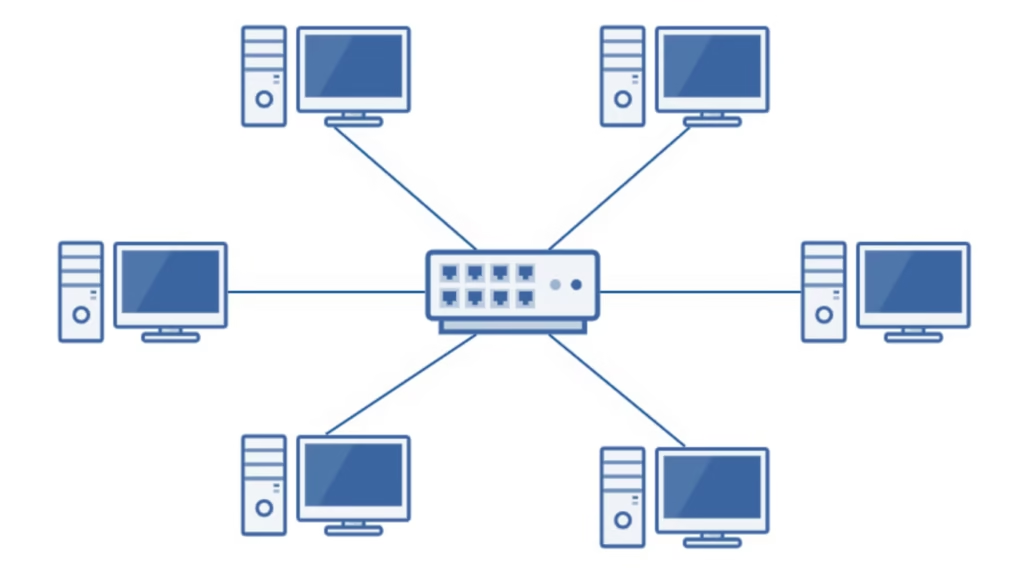ORK TOPOGRAPHY

Network Topology refers to the physical or logical arrangement of network devices, such as computers, routers, switches, and other network components, and how they are connected to each other within a network. It defines the structure and the way data flows across the network, affecting performance, reliability, scalability, and troubleshooting.
There are several common types of network topologies, each with its advantages and disadvantages, depending on the needs of the network.
Common Types of Network Topologies:
- Bus Topology:
- Structure: In a bus topology, all devices are connected to a single central cable (the “bus”) that carries data between them.
- Data Transmission: Data sent by a device travels along the bus and is received by all other devices connected to the bus, but only the intended recipient processes it.
- Advantages:
- Easy to implement and cost-effective for small networks.
- Requires less cable than other topologies.
- Disadvantages:
- The entire network can fail if the bus cable is damaged.
- Performance degrades as more devices are added, due to collisions on the network.
- Ring Topology:
- Structure: Devices are connected in a closed loop or ring, with each device directly connected to two others (one on each side).
- Data Transmission: Data travels in one direction around the ring, passing through each device until it reaches the destination.
- Advantages:
- Data flow is predictable, and performance is relatively consistent.
- Easier to install and configure than bus topology in smaller networks.
- Disadvantages:
- If one device or cable fails, the entire network can be disrupted.
- Troubleshooting can be more challenging.
- Star Topology:
- Structure: All devices are connected to a central hub or switch. The hub acts as a mediator for data transmission between devices.
- Data Transmission: Data sent by a device is directed to the central hub, which then forwards it to the destination device.
- Advantages:
- Easy to add new devices without disrupting the network.
- Centralized management, making it easier to troubleshoot.
- Failure of one device doesn’t affect the rest of the network.
- Disadvantages:
- If the central hub fails, the entire network is affected.
- More cables are required, making it less cost-effective for large networks.
- Mesh Topology:
- Structure: Every device is connected to every other device in the network. This is a highly redundant setup.
- Data Transmission: Data can take multiple paths to reach its destination, offering high resilience.
- Advantages:
- Highly reliable due to multiple paths for data transmission.
- Failure of a single device or connection doesn’t disrupt the network.
- Disadvantages:
- Requires a lot of cabling and can become expensive for large networks.
- Complex to set up and maintain due to the number of connections.
- Tree Topology (Hierarchical Topology):
- Structure: This is a hybrid topology, combining elements of star and bus topologies. Devices are connected in a hierarchical fashion, with groups of star-configured devices connected to a central bus.
- Data Transmission: Data flows through the central bus and can be directed to different branches of the network.
- Advantages:
- Scalable and suitable for large networks with a hierarchical structure.
- Failure in one branch doesn’t affect the entire network.
- Disadvantages:
- The central bus can become a bottleneck if traffic is high.
- More complex and expensive to implement than basic topologies.
- Hybrid Topology:
- Structure: A hybrid topology combines elements from two or more different types of topologies, such as a combination of star, bus, or ring.
- Data Transmission: Data transmission depends on the specific combination of topologies being used.
- Advantages:
- Flexible and adaptable to the specific needs of the organization.
- Offers the benefits of different topologies, depending on the network’s requirements.
- Disadvantages:
- Can be complex to design, implement, and maintain.
- The cost can increase based on the number of different topologies integrated.
Visual Comparison of Topologies:
- Bus Topology: A single line with all devices connected along it.
- Ring Topology: A circular arrangement, where each device is connected to two others, forming a closed loop.
- Star Topology: All devices connected to a central hub or switch, like spokes on a wheel.
- Mesh Topology: Devices interconnected with every other device in the network, creating a web-like structure.
- Tree Topology: A branching structure, with central “roots” and “branches” leading to various devices.
- Hybrid Topology: A combination of two or more of the above topologies to suit a particular need.
Factors to Consider When Choosing a Network Topology:
- Scalability: How easy is it to add new devices to the network without causing major disruptions or significant additional costs?
- Cost: Some topologies, like mesh or hybrid, can be more expensive to implement due to the need for additional cables, hardware, and complex setups.
- Reliability: Does the network need redundancy and fault tolerance, such as in mesh topology, or is a simpler setup sufficient for smaller networks?
- Performance: Some topologies are more efficient in terms of data transmission speeds (e.g., star topology can offer better performance in small to medium-sized networks), while others can suffer from performance degradation with increased traffic (e.g., bus topology).
- Ease of Maintenance: Some topologies, such as star or tree, are easier to maintain and troubleshoot due to their central management or hierarchical structure.
- Failure Tolerance: In cases where network reliability is critical, mesh or hybrid topologies provide the highest fault tolerance.

Conclusion:
The choice of network topology depends on factors like the size of the network, its purpose, cost, and reliability requirements. Smaller networks might benefit from simpler topologies like star or bus, while larger, more complex networks could be better suited to mesh or hybrid topologies for enhanced fault tolerance and scalability. Each topology has trade-offs in terms of cost, performance, and complexity, so understanding these aspects is crucial when designing a network.

Leave a Reply